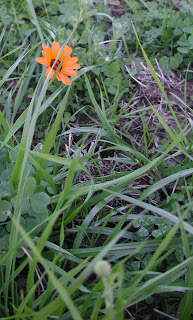
A good weekend's worth of work, the bee boxes come unassembled and unpainted. With the three farm hives building up gentle Italian workers for our spring clover, and a colony (or nuc, for nucleus) of hearty Russians in the works, I must try to stay ahead of their housing (and honey storage) needs. A lot of nails, glue, and three coats of exterior enamel have these hive supers ready for the honey flow. Now, there are only 81 honey comb frames (nine per box) to go. Yikes! What have I gotten into.
Thais wanted me to explain what the Russian bees are about, and I will try to be brief. If you've been following the blog, you know we got into bees last spring because there were so few honeybees around the farm. One of the reasons for the dearth of bees is that so many of the native honeybee populations were decimated by a number of honeybee pests imported from overseas. One of the worst of these, the varroa mite, plagues the bees, attaching to their brood while still developing in their cells and holding on through the adult bees lives unless groomed or knocked off. If the infestation becomes too great, the hive will lose so many bees that it will die off or swarm away. Commercial beekeepers, and many hobbyists, keep the mites in check by treating their hives with miticides (essentially poisons), which are hard on the bees and can leave residual traces in the honey and comb. Can you say organic farm? It won't happen here.
Hence, the Russians. Unlike the Italian honeybees (also imported to America), which had never been exposed to varroa mites, Russian bee stock comes from the same part of the world as varroa mites (eastern Russia-western China) and are thus better adapted through behaviors (removal of mites from infected cells, grooming, etc.) that keeps the mites in check. They do so much better, in fact, that chemical treatment is not needed. So less than a year into beekeeping and I am already trying to adapt to the ever-changing insect world. By the way, I will not get rid of my Italian ladies, not directly anyway. I will eventually requeen the hives with Russian queens and my Italians will slowly develop a decidedly Slavic accent. In the mean time, there are non-chemical tricks to limit the damage to the Italian hives. I will miss my more gentle Italians, but the honey will still be just as sweet.









